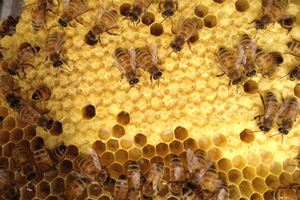- All-In-One Beekeeping for the Bees
- +1-608-728-8233
- info@beepods.com
Winter Duties

Winterized Beepods protecting our bees from the harsh Wisconsin winter!
Halloween is officially over and low temperatures are approaching – what does this mean for honey bees? Honey bees prefer warmer temperatures around 55-100℉, so when it gets colder than that, it makes life a little more difficult for them. Dropping temperatures means they cannot fly well, so their activity level decreases tremendously. With less activity, this means less foraging, so they must focus on other tasks at hand like taking care of the queen. This is their main focus all winter long and until the temperature starts to rise, so how exactly do they take care of their queen?
Honey Bee Cluster
Keeping their queen safe essentially means they need to keep the queen bee warm throughout the cold winter. Any time the temperature drops to around 57℉, bees in a hive collapse into what we call a cluster. A cluster is just a term for when all of the honey bees in the hive form a ball in order to preserve heat. The closer they get to each other and the bigger the cluster gets, the warmer their hive will be. A honey bee cluster is considered the main brood area of the hive and many people like to call it “the heart of the hive” during the cold months.

In the real heart of the cluster is the queen bee. All of the honey bees will swarm around her to make sure that she is always at the center and protected by warmth. At the center of the winter cluster, temperatures can be up to 90-100℉, while at the surface temperatures can still be as low as 50℉. With temperatures still being too low for those bees at the surface, the cluster will rotate to evenly distribute heat so that no worker bee gets too cold.
Energy
Forming the cluster is essential for the honey bees survival and their queens survival, but in return it uses up a lot of their energy. The constant fluttering of their wings is how they keep from shivering, but this gets exhausting! It is essential that these bees have enough honey in order to survive. As a beekeeper, it’s your job to make sure that honey bees have enough honey stored to get them through the winter. This is one of our top priorities and missions at Beepods, and it’s a big part of what makes our beekeeping practices sustainable. If beekeepers do not leave enough honey for the bees, they will not survive. You can read more about unsustainable beekeeping here.

Use your tools. Inspect your hive. Do your best to make sure your bees survive the winter.
If you are a beekeeper, ensuring that your honey bees have enough honey is really your most important task. Honey bees are equipped to survive on their own as long as they are adequately fed. Keep in mind, on average bees need around 60-90 lbs of honey to survive the winter, so it is important to not leave less than this. The amount can vary slightly depending on how big your hive is and whether or not some bees have died off. There are possibilities of older bees dying, so it is better if you have a large cluster to start off with in order to sustain the death of some bees.
Final Thoughts
As winter approaches, honey bees have a tough time. They need to cluster and store enough honey in order to survive the cold months ahead. If you think your bee colony may be facing challenges due to lack of food or resources, it’s important that you check up on them before they get too weak from starvation during these next few weeks leading into the colder season. Winter will be here before you know it, so make sure you adequately prepare your bees for it. Be sure your bees have enough honey, but also make sure to read our November Honey Do Checklist so you are prepared for the winter.
Elizabeth Allon
Latest posts by Elizabeth Allon (see all)
- Short But Mighty: The Stages of Life - January 26, 2022
- Honey Bees Vs. Highways - January 19, 2022
- 4 Ways to Save The Bees in 2022 - January 12, 2022



